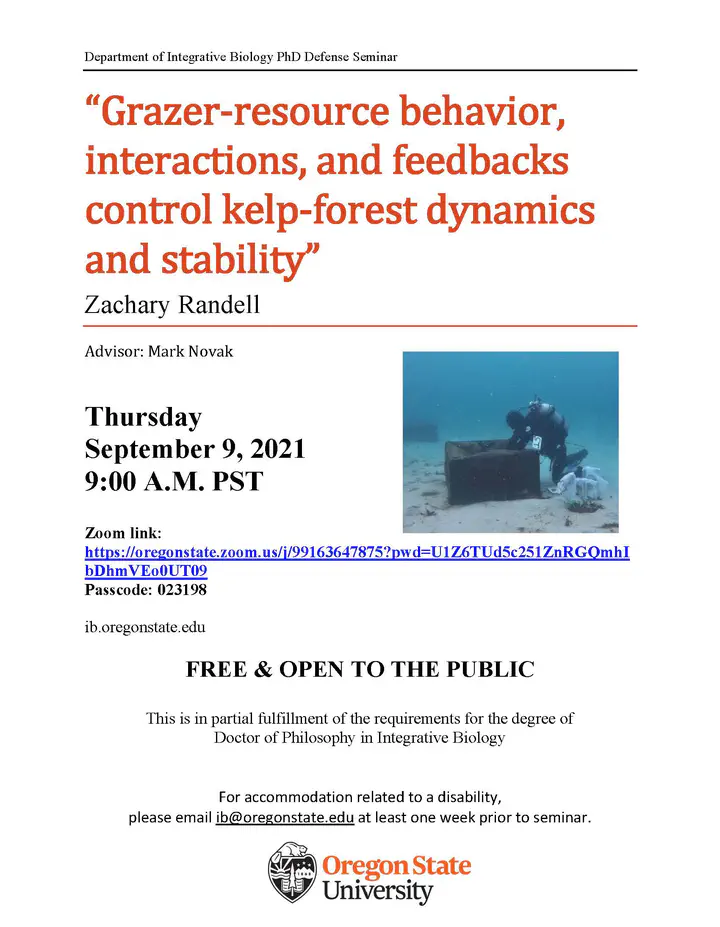Grazer-resource behavior, interactions, and feedbacks control kelp-forest dynamics and stability
PhD

Abstract
How the direct and indirect effects of species interactions cascade to affect community struc- ture, functioning, and stability is a fundamental question in ecology. In temperate kelp forests, species interactions, in conjunction with environmental processes, produce rich spatiotemporal dy- namics. Arguably the most dramatic of these are abrupt shifts in community state, where forested locations are grazed by herbivorous urchins to establish what is known as an “urchin barren”. The increasing frequency and intensity of perturbation events associated with climate change have in- creased the frequency of shifts towards the barren-state. Understanding not only the mechanisms precipitating state shifts but also those that stabilize both the forested and barren states is essential to guide effective kelp-forest conservation and management strategies. Central to urchin barren establishment is a switch in behavior, where urchins leave cracks and crevices to move across the seafloor and graze upon kelp. While it is known that urchin predators can control urchin density and behavior, it is less clear how resource availability affects urchin behavior, or how the switch in behavior affects kelp-forest dynamics at large. This dissertation evaluated urchin behavior, the “bottom-up” processes controlling it, and the subsequent effects upon kelp-forest dynamics and stability from three distinct directions. In Chapter 2, I analyzed 38 years of kelp-forest community data and found distinct spatiotem- poral patterns: certain sites exhibited abrupt shifts in state, others exhibited resilient kelp-forest persistence. I suggest that substrate complexity (the rugosity of the benthic substrate) modified both “top-down” and “bottom-up” processes regulating urchin density and behavior. In particular, I suggest that substrate complexity altered the retention of drift algae (also known as kelp detritus, and henceforth, drift)—the senescent form of kelp that has detached from the seafloor. Urchins are believed to prefer drift, such that when drift is abundant urchin remain inactive, consume the drift, and do not graze live kelp. Variation in the retention of drift may thus in-part be responsible for the urchin behavioral switch that leads to the establishment and stabilization of the barren state. In Chapter 3, I used a one-consumer (urchins) two-resource (kelp and drift) model to test if and how a switch in urchin grazing can precipitate kelp-forest dynamics such as alternative stable states and the emergence of kelp population cycles. Under the assumption that urchins prefer drift over live kelp, results demonstrated that all shifts in state are associated with urchins switching between resources. In Chapter 4, I experimentally tested the core assumption from Chapter 3, i.e., that urchins “prefer” drift. Specifically, I used a subtidal caging experiment to evaluate the density-dependent effects of drift and kelp upon urchin consumption rates. Results demonstrated a strong preference in urchins to consume drift, that kelp consumption is controlled by the availability of drift (not by kelp itself), and that urchins exhibit a rank switch—a switch in the proportion of resources consumed as total biomass increases—from kelp to drift. Altogether, this dissertation used long-term monitoring, dynamical modeling, and subtidal experimentation to evaluate the influence of grazer-resource behavior, interactions, and feedbacks upon kelp-forest dynamics and stability. While urchin predators are predominantly thought to control the switch in urchin behavior, I demonstrate how resource availability can also control this behavioral switch. This may help explain shifts to the urchin barren state at locations where urchin predator abundances remain unchanged. Furthermore, my inferences involving substrate complexity and drift as a preferred urchin resource point towards potential strategies with which to conserve or restore kelp-forest ecosystems.